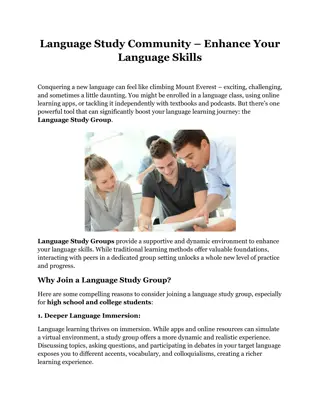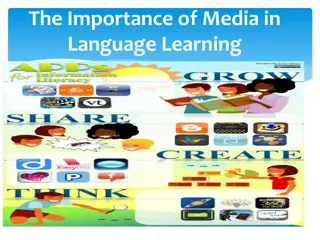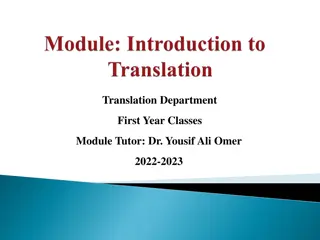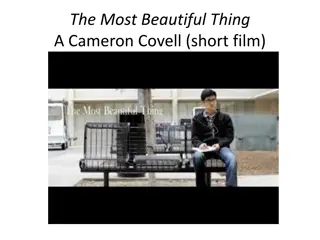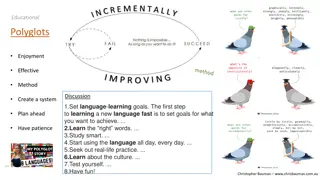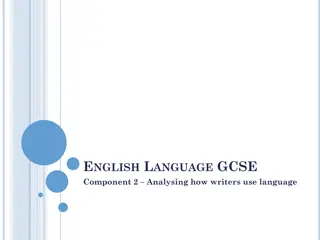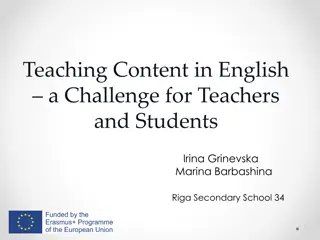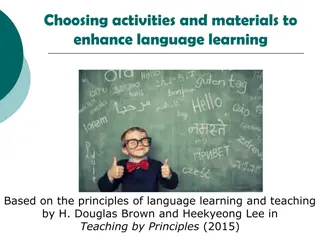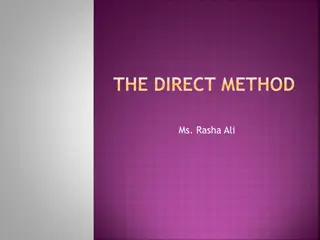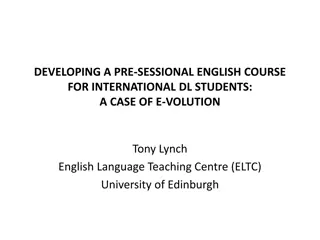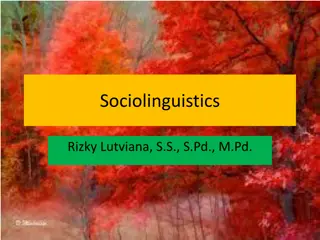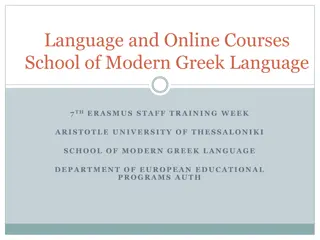Effective Language Learning Tips for Students
The best way to get accustomed to language is through regular reading of newspaper articles from trusted sources like BBC, The Guardian, and The Telegraph. Familiarize yourself with exam patterns by bringing an article to class for discussion. Prior to writing exams, read passages thoroughly, skim through questions, and pay attention to details like bold text. Utilize your own words when answering questions and quote passages when necessary. Follow these tips for scoring well in language exams.
Download Presentation

Please find below an Image/Link to download the presentation.
The content on the website is provided AS IS for your information and personal use only. It may not be sold, licensed, or shared on other websites without obtaining consent from the author.If you encounter any issues during the download, it is possible that the publisher has removed the file from their server.
You are allowed to download the files provided on this website for personal or commercial use, subject to the condition that they are used lawfully. All files are the property of their respective owners.
The content on the website is provided AS IS for your information and personal use only. It may not be sold, licensed, or shared on other websites without obtaining consent from the author.
E N D
Presentation Transcript
GETTING USED TO THE LANGUAGE The best way to get used to the language used in these articles is to read it. The best practice you can give yourself is making time once a week to read a newspaper article. Your parent s might have these lying around, but you can also find these online: http://www.bbc.co.uk/news http://www.theguardian.com/uk http://www.telegraph.co.uk/ Read the comment features these are often the source of the exam papers! Your task: Your task: Bring in an article to class for Monday. This can be from any of these sources or actual newspapers. Read it and be prepared to talk about it.
THE EXAM! Marked out of 30. Marked out of 30. 1 hour to finish. 1 hour to finish. Read the passage and Read the passage and answer the answer the questions (around questions (around 9). 9). Blue or black ink. Blue or black ink. Mark the question you Mark the question you are attempting. are attempting.
BEFORE YOU WRITE You should read through the passage twice carefully. If you are not a fast reader then you could read through the passage once thoroughly and then when a question asks you to look at a certain paragraph make sure that you read that paragraph again. This will save you time overall.
BEFORE YOU WRITE You should then have a quick skim through the questions before you begin. If you feel that you do not have time to do this then you should at least skim through the questions page by page as you come to them.
BEFORE YOU WRITE Study any accompanying photographs. If there is one, remember to read the introduction to the passage, as it will give you a general idea of what theme / topic the passage deals with.
TIPS FOR TOP MARKS Read the question carefully Look for bold type bold type in the question. These are the important parts of the question. If the question directs you to a particular paragraph, only only use quotes from that section. Check how many points how many points each question is worth. Always use your own words own words if asked. Quote Quote from the passage if directed. carefully before you begin.
UNDERSTANDING QUESTIONS Questions that ask you to show that you can explain the main ideas of the text. Questions that ask you to show that you can explain the main ideas of the text. In your own words questions Context questions Summary question Linking questions
WHEN TO QUOTE Look at these words and phrases you might find in questions. Which expressions tell you that you ought to quote in your answer and which ones suggest you write in your own words? 1. Why do you think ? 2. Which word ? 3. Explain fully ? 4. Find an expression ? 5. How does the writer ? 6. Write down the word ? 7. Which expression ? 8. By close reference to the text .?
IN YOUR OWN WORDS QUESTIONS Unless you are asked for a quote or evidence you should always use your own words. This is how you show that you understand what the writer is saying. These questions are trying to test your vocabulary. How to answer: How to answer: Look at the passage the question directs you to and find the Look at the passage the question directs you to and find the idea/answer/line and put it IN YOUR OWN WORDS. idea/answer/line and put it IN YOUR OWN WORDS. Don t attempt a word for word translation . Explain the idea rather than substituting individual words. Caution: Sometimes there will be words you are not expected to change.
EXAMPLE Total-immersion courses based in Italian families are seen by some as a valid alternative to college studies. Some people believe that living full-time with an Italian family is just as successful as studying Italian at college. There are those who think that sharing life with an Italian family will benefit you as much as learning Italian in a more academic setting.
YOUR TURN Since the day the Romans stepped beyond Hadrian s Wall, enemy armies have probably come to a halt at the sight of the Scottish infantry: short, red-headed blokes who might at first turn out to be ferociously terrier-like. Their latter-day equivalents were the likes of Jimmy Johnstone and Billy Bremner, dinky-sized footballers who ran rings around their opponents, and in so doing gave their fellow gingers a much-needed confidence boost. Using your own words explain why over the centuries it has been a mistake to judge Using your own words explain why over the centuries it has been a mistake to judge Scottish soldiers and footballers by their appearance. Scottish soldiers and footballers by their appearance. Despite looking unusual, being short and red-haired, the Scottish soldiers never gave up on their fierce attacks on the Roman invaders. In later years, some Scottish footballers of similar appearance were equally effective when confronting the opposition.
TRY THIS I m nocturnal. I love the moonlight, the shadows, the dark places, the dappled murk. I m not being poetic. I m simply being true to my nature, my nocturnal nature. Like all tarantulas. Question: Question: In your own words, in what way is the speaker like all In your own words, in what way is the speaker like all tarantulas according to the first paragraph? (1 Mark tarantulas according to the first paragraph? (1 Mark) ) An acceptable answer would be: The speaker is active by night. Don t make this too complicated, it s only worth one mark! Extra practice: p.30 Bright Red
CONTEXT QUESTIONS You may be asked to show how the context, that is the words or phrases around an unusual word, that give us an idea of what an unfamiliar word may mean. The marker doesn t expect you to know the meaning of the word, they just want you to show that you can figure it out using what surrounds it in the passage. Example: Show how the first sentence provides a context which enables you to understand the meaning of the word ... Explain in your own words what is meant by ______ in this context
THE FORMULA Usually worth 2 marks. 1.Show what the word means, 2.Show how you work this out from the context. The word/expression __________ as used here means _________. I can work this out from the context because .
EXAMPLE At Guy s and St Thomas hospitals in London, an initiative was set up two years ago to help people aged 18 to 30 with autism gain work experience. Staynton Brown, associate director of equality and diversity at the hospital, dismisses any suggestion of the initiative being a philanthropic one. This is not a charitable gesture, he said. We want to make sure we have the most talented workforce possible. It s in our interests in multiple ways. We ve all benefitted from the changes we ve incorporated to accommodate those with autism. By interns into the hospital, we ve made communication clearer for everyone which leads to better patient care. How does the context of the second paragraph help you to work out what is meant by How does the context of the second paragraph help you to work out what is meant by philanthropic ? philanthropic ?
MODEL ANSWER The word philanthropic as used here means done out of feelings of charity or solely for the good of others. I worked this out from the context because the expression is followed with the idea that employing people with autism is not charitable .
YOUR TURN At Guy s and St Thomas hospitals in London, an initiative was set up two years ago to help people aged 18 to 30 with autism gain work experience. Staynton Brown, associate director of equality and diversity at the hospital, dismisses any suggestion of the initiative being a philanthropic one. This is not a charitable gesture, he said. We want to make sure we have the most talented workforce possible. It s in our interests in multiple ways. We ve all benefitted from the changes we ve incorporated to accommodate those with autism. By interns into the hospital, we ve made communication clearer for everyone which leads to better patient care. 1. 1. Show how the context helps you to understand the meaning of the word Show how the context helps you to understand the meaning of the word accommodate as it is used here. (2) accommodate as it is used here. (2) 2. 2. How does the context of these paragraphs help you to understand the word intern How does the context of these paragraphs help you to understand the word intern as it is used here? (2) as it is used here? (2)
CHECK YOUR ANSWERS Mark a partner s answers using the marking scheme: 5. Candidates should demonstrate understanding of the meaning of the word and provide contextual evidence of how they arrived at this for 1 + 1 mark. Meaning: to make allowance/adjustments for someone; to make it easier for someone to fit/settle in. Context: reference to the changes made to accommodate staff with autism. 6. Candidates should demonstrate understanding of the meaning of the word and provide contextual evidence of how they arrived at this for 1 + 1 mark. Meaning: person working to get experience. Context: reference to or quotation of work experience .
MONDAY 30THNOVEMBER 1. Your articles. 2. Summary and linking questions overview. 3. Understanding questions practice. 4. Peer marking. Homework for Monday (7/12/15): Complete understanding practice Homework for Monday (7/12/15): Complete understanding practice if not done in class. if not done in class.
UNDERSTANDING QUESTIONS Questions that ask you to show that you can explain the main ideas of the text. Questions that ask you to show that you can explain the main ideas of the text. In your own words questions Context questions Summary question Linking questions
STARTER STARTER Articles due today Articles due today with 2 understanding with 2 understanding- -style questions. style questions. Show and discuss your article with the person next to you. What was it about? Identify the main points. Find an example of word choice you might speak about. Find an example of figurative language (alliteration, simile, metaphor, onomatopoeia, etc.)
ARTICLES ARTICLES Your homework for Monday (30thNovember) is to think of 2 close reading style questions questions that you might ask about your article. These should be understanding questions understanding questions like the ones you looked at on Monday. Write out your questions and bring them in on Monday with the article. 2 close reading style 1. Have someone else read your article and attempt your questions (writing their answers in their jotter). Once you are finished swap your jotters and mark your partner s answers. 2. Those without articles or questions can make notes on pages 28-33 of the pink book until we are finished.
SUMMARY QUESTIONS These test your understanding of the writer s key These test your understanding of the writer s key ideas. ideas. You may be asked to consider the whole passage or quite a lengthy section. Underline/highlight the main points. Make the same number of points as there are marks. Use your own words. Look out for the really important or big ideas the examiner is not interested in you summarising the less important points.
FOR PRACTICE 1 Context: This is an extract from an article in the Scotsman about Elizabeth Taylor, a famous actress in the 50s and 60s. Of course, those born in the 1970s may find celebrity on the Taylor scale hard to understand. The whole concept of celebrity has been degraded, over the last two centuries by an avalanche of media coverage which makes no pretence of interest in the actual work that well-known people do, but instead focuses entirely and insidiously on the personal lives, and most particularly the personal appearance, of anyone who has ever been in the public eye for anything, from behaving like an idiot on reality TV, to having sex with a premiership footballer. What three main criticisms does the writer make of the way the media treat celebrities today? (3)
FOR PRACTICE 1 ANSWER The media relentlessly pursues stories on celebrities But they are not interested in the actual merits of the celebrities or their achievements Instead, they seek scandalous stories in order to expose these celebrities.
FOR PRACTICE 2 Context: This is an extract from an article in which the writer identifies factors which she feels contribute to a real sense of traditional family life in meltdown . The first is the relative ease of divorce, which, particularly for low income families removes the ancient pressure on women to put up with bad marriages for the sake of respectability. Unhappy wives are now free to leave with their children, a freedom which some men deeply resent. The second is the growing number of society, and collapse of traditional communities which often leaves the children of broken marriages without a support system of neighbours and relatives to cushion the blow. And the third is the remarkably unreconstructed workplace culture within which British parents still have to function, tolerating chronic loss of earnings and status if they make family life a priority, and often having to work unacceptably long hours if they want to remain in employment at all. Summarise three factors which the writer identifies as possible causes of the breakdown of family life. (3)
FOR PRACTICE 2 ANSWER It is no longer as difficult to get a divorce: it is not as expensive as it was and it is no longer frowned upon in the same way. No longer such a sense of unity with other members of their residential area so children are left with even less parental figures than before. Finally, there is much more emphasis on careers and working more, thus meaning that family time suffers.
LINKING QUESTIONS These test your understanding of how texts and These test your understanding of how texts and paragraphs are paragraphs are structured. structured. You are asked to identify linking words or phrases. You must then explain how they form a link in the writer s argument.
LINKING QUESTION FORMULA There are four steps to a successful answer: 1. 1. a quotation (from the link sentence) which refers back a quotation (from the link sentence) which refers back 2. 2. an understanding of the way in which it refers back an understanding of the way in which it refers back 3. 3. a quotation (from the link sentence) which refers forward a quotation (from the link sentence) which refers forward 4. 4. an understanding of the way in which it refers forward an understanding of the way in which it refers forward Note: you should also watch out for words like but , however or on the other hand which would suggest a contrasting point to come or a turn to the other side of the argument.
EXAMPLE LINKING QUESTION EXAMPLE LINKING QUESTION Winnie the Pooh and Christopher Robin skipped happily away into the Hundred Acre Wood. However, Eeyore sat sadly, wondering where everyone had gone. He was so lonely. How does the first sentence of the second paragraph create an effective link?
EXAMPLE LINKING QUESTION ANSWER Winnie the Pooh and Christopher Robin skipped happily away into the Hundred Acre Wood. However, Eeyore sat sadly, wondering where everyone had gone. He was so lonely. How does the first sentence of the second paragraph create an effective link? Wondering where everyone had gone refers back to the idea that Winnie the Pooh and Christopher Robin had left Eeyore alone in the woods. Sat sadly links forward to the idea that Eeyore is feeling unhappy being left by himself.
FOR PRACTICE 1 The First Emperor's imprint on the lives of the inhabitants of his far-flung kingdoms was seen further. He unified the script, demanding that all states write the pictographs of ancient Chinese in the same way. So, although the words might be pronounced differently in different parts of the empire, once they were written down everyone who could read could understand each other, a particular advantage for traders. But for the First Emperor, establishing complete control over his empire was not enough. He wanted to rule forever. If he couldn't have immortality in this world, the next best thing would be to rule in the nether world. We knew about his tomb mound because the ancient sources referred to it, and it has always been there. Explain how the sentence But for the First Emperor, establishing complete control over Explain how the sentence But for the First Emperor, establishing complete control over his empire was not enough works as a link between paragraphs at this point his empire was not enough works as a link between paragraphs at this point. (2) . (2)
ANSWER 1 The conjunction but suggests the point made in the next paragraph will contrast with the previous one. Establishing complete control over his empire refers back to the previous paragraph which explained how standardising a written script helped the Emperor to dominate his people. Was not enough refers forwards to the next paragraph which explains that his ambitions were even wider and that the Emperor wanted to extend his power into the afterlife. Is this answer worth 2, 1 or 0? Is this answer worth 2, 1 or 0? 2 2
ANSWER 2 The first part of the sentence points back to the previous paragraph and the remainder of the sentence points forward to the points developed in the next paragraph. Is this answer worth 2, 1 or 0? Is this answer worth 2, 1 or 0? 0 0
ANSWER 3 This sentence forms a link as the expression was not enough shows that the Emperor was not satisfied with what he had achieved by dominating his empire and wanted more. Is this answer worth 2, 1 or 0? Is this answer worth 2, 1 or 0? 1 1
FOR PRACTICE 1. He worked hard when he was young, always putting in long hours. After so many backbreaking years, he wanted to take it easy. In his old age he spent most of his time fishing. 2. When the sun sank down it was a luxury to sit in the perfumed air and forget that there was any world but these enchanted islands. It was such ecstasy to dream, and dream till you got a bite. A scorpion bite. Then the first duty was to get up out of the grass and kill the scorpion; and the next to bathe the bitten place with alcohol and the next to resolve to keep out of the grass in the future. Explain how the underlined sentences act as a link at that point in the extracts. (2)
UNDERSTANDING QUESTIONS PRACTICE Read the short Orphans passage and answer the questions. This should take about 25 Read the short Orphans passage and answer the questions. This should take about 25 minutes. minutes. As you read, highlight what you think are the main points or ideas of the passage. Read the question fully. Pay attention to the points. Notice the words in bold. If you finish early, there is always revising to do! (of poetry or The Lighthouse ) 1. Swap your passage with the person next to you. 2. Mark their answers using the answering scheme by highlighting where they have got a correct answer.
ORPHANS ANSWERING SCHEME. 1. 1. They did originally have a family. They were thrown out. They ran away. Their families could not support them. Any 3 for 1 mark each: Any 3 for 1 mark each: 4. A link between these paragraphs is established because the line Such children were simply unnoticed from the first sentence of paragraph 2 links to the idea of children as invisible at the end of paragraph 1. It continues the discussion of these unnoticed children. 5. 2 advantages for 1 point each: Advantages stealing was easy. Disadvantages children were often homeless; when they could find work they were often exploited. 2. 2. A detailed summary of In the prevailing conditions A detailed summary of In the prevailing conditions of extreme poverty of extreme poverty . : . : At times when families were very poor, children were only given close attention in the very early stages of their lives. 6. Status of rats sums up the main ideas of the passage because: Children then often had to run away in the same way that rats do. They had to find shelter, food and live unseen in the same way that rats do. They were also, in some ways, unloved, as are rats. 3. 3. Children had to be much more independent than they have to be now. They were treated like adults. They did not have the development and resources that adults had. 2 differences explained for 1 point each: 2 differences explained for 1 point each:



